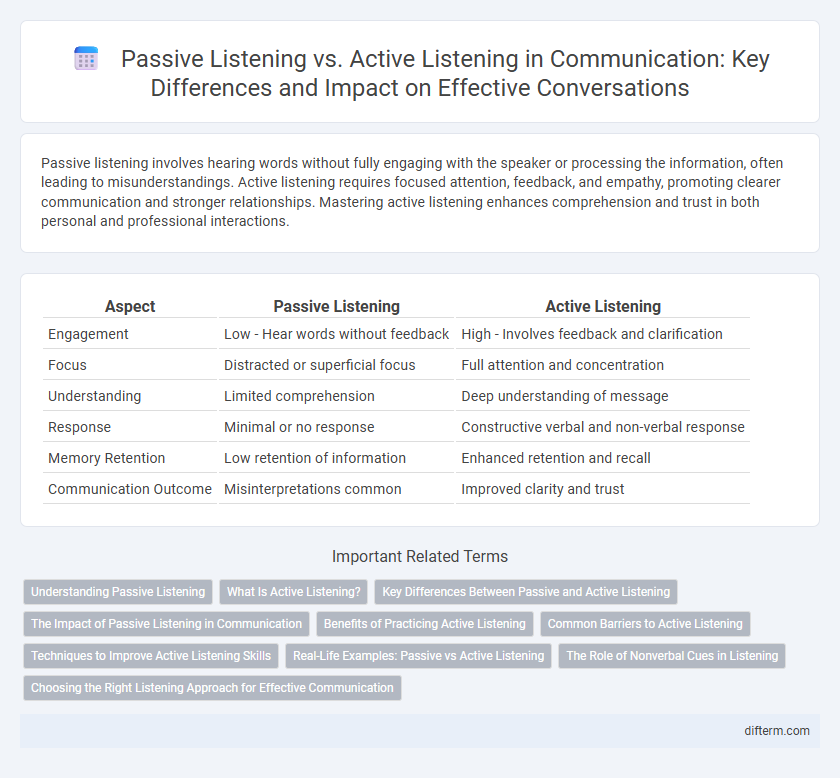Passive listening involves hearing words without fully engaging with the speaker or processing the information, often leading to misunderstandings. Active listening requires focused attention, feedback, and empathy, promoting clearer communication and stronger relationships. Mastering active listening enhances comprehension and trust in both personal and professional interactions.
Table of Comparison
| Aspect | Passive Listening | Active Listening |
|---|---|---|
| Engagement | Low - Hear words without feedback | High - Involves feedback and clarification |
| Focus | Distracted or superficial focus | Full attention and concentration |
| Understanding | Limited comprehension | Deep understanding of message |
| Response | Minimal or no response | Constructive verbal and non-verbal response |
| Memory Retention | Low retention of information | Enhanced retention and recall |
| Communication Outcome | Misinterpretations common | Improved clarity and trust |
Understanding Passive Listening
Passive listening involves hearing words without engaging cognitively or emotionally, resulting in limited comprehension and retention of information. This form of listening often leads to misunderstandings and ineffective communication because the listener does not provide feedback or clarify points. Recognizing passive listening enables individuals to shift towards active listening, which fosters deeper understanding and connection.
What Is Active Listening?
Active listening involves fully concentrating, understanding, and responding thoughtfully to the speaker, which enhances effective communication and minimizes misunderstandings. Unlike passive listening, active listening requires engagement through verbal affirmations, body language, and feedback to confirm comprehension. This skill fosters stronger relationships by promoting empathy and ensuring that information is accurately received and processed.
Key Differences Between Passive and Active Listening
Passive listening involves hearing sounds without fully processing or responding to the message, often leading to misunderstandings and missed information. Active listening requires focused attention, interpreting verbal and nonverbal cues, and providing feedback to confirm understanding, which enhances communication effectiveness. Key differences include engagement level, retention rate, and responsiveness, with active listening promoting better interpersonal connections and problem-solving outcomes.
The Impact of Passive Listening in Communication
Passive listening in communication often leads to misunderstandings, reduced information retention, and diminished trust between parties. It causes critical details to be overlooked, weakening collaboration and problem-solving effectiveness. Organizations experiencing high levels of passive listening report decreased employee engagement and impaired decision-making processes.
Benefits of Practicing Active Listening
Practicing active listening enhances communication effectiveness by fostering better understanding and reducing misunderstandings between parties. It promotes empathy and trust, allowing speakers to feel valued and heard, which strengthens relationships. Active listening also improves problem-solving skills as it encourages attentive engagement and critical thinking during conversations.
Common Barriers to Active Listening
Common barriers to active listening include distractions, preconceived notions, and emotional biases that hinder full engagement with the speaker's message. External noises and internal thoughts often divert attention, reducing comprehension and retention of information. Misinterpretations arise from selective hearing, preventing effective communication and understanding between parties.
Techniques to Improve Active Listening Skills
Active listening techniques include maintaining eye contact, providing verbal affirmations like "I see" or "Go on," and summarizing key points to confirm understanding. Asking open-ended questions encourages deeper dialogue and demonstrates engagement with the speaker's message. Minimizing distractions and focusing fully on the speaker enhances retention and fosters genuine connection in communication.
Real-Life Examples: Passive vs Active Listening
Passive listening occurs when a person hears words without fully engaging, such as during a crowded meeting where attention drifts, leading to missed details and misunderstandings. Active listening involves techniques like paraphrasing and asking clarifying questions in conversations, as seen in customer service interactions where understanding client needs directly improves satisfaction. Real-life examples show active listening boosts relationship building and problem-solving, while passive listening often results in communication breakdowns and unresolved conflicts.
The Role of Nonverbal Cues in Listening
Nonverbal cues such as eye contact, facial expressions, and body language play a crucial role in active listening by signaling attention and understanding, which passive listening often lacks. Active listeners use these nonverbal signals to provide feedback and encourage the speaker, enhancing communication effectiveness. The absence of engaged nonverbal responses in passive listening can lead to misunderstandings and a breakdown in interpersonal communication.
Choosing the Right Listening Approach for Effective Communication
Active listening enhances communication by requiring full attention, feedback, and engagement, which helps in accurately understanding messages. Passive listening, while less demanding, can lead to misunderstandings and reduced information retention due to limited involvement. Selecting active listening in critical conversations fosters clarity, trust, and stronger interpersonal connections, ensuring effective communication outcomes.
passive listening vs active listening Infographic

 difterm.com
difterm.com